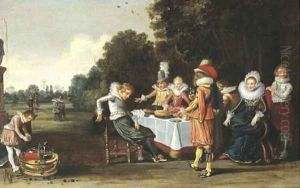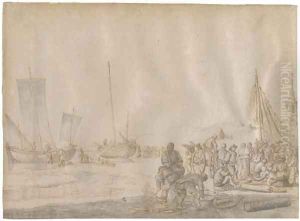Esaias Van Den Velde Paintings
Esaias van den Velde was a pivotal figure in the development of Dutch landscape painting in the early 17th century. Born in 1587 in Amsterdam, he was a part of the Northern Netherlands' artistic community during a period of significant cultural and economic growth known as the Dutch Golden Age. His father, Hans van den Velde, was a Flemish painter who likely provided Esaias with his initial training in art.
Van den Velde moved to Haarlem at a young age, where he became a student of landscape painter Gillis van Coninxloo. It was in Haarlem that he became associated with the group of artists known as the 'Haarlemse School' or the 'Pre-Rembrandtists.' This group was known for their more naturalistic approach to landscape painting, which was a shift from the Mannerist style that had been dominant in the late 16th century.
In his early career, van den Velde painted landscapes that were heavily influenced by his teacher Coninxloo, featuring wooded scenes with high horizons and an emphasis on foliage. However, as his style matured, he began to lower the horizon in his landscapes to offer a more expansive view of the Dutch countryside. He became known for his winter scenes, beachscapes, and depictions of military encampments, bringing a sense of realism and detail to his work that was innovative for the time.
Van den Velde's move to The Hague in 1618 marked the beginning of his most productive period. He became a founding member of the artists' guild in The Hague and was highly influential in the spread of the realist landscape style. His work from this period shows a keen observation of light and atmospheric conditions, and he often included figures and animals to bring life and scale to his landscapes.
Esaias van den Velde's influence extended beyond his own paintings. He was also a teacher, passing on his techniques and style to a number of students, including Jan van Goyen, who would become one of the most important Dutch landscape painters of the 17th century. Van den Velde's impact on Dutch art was significant in establishing landscape as a respected genre in its own right, and his approach to painting the natural world would inform the work of many artists who followed.
Van den Velde died in The Hague in 1630, leaving behind a legacy as a pioneer of Dutch landscape painting. His works are held in high regard and can be found in major museums around the world, where they continue to be studied and appreciated for their contribution to the evolution of landscape art.

